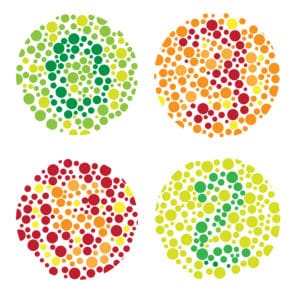Can Glasses Really Fix Colorblindness? (EnChroma & Others)
Home / Everything About Glasses /
Last Updated:
Table of Contents
Color blindness, also called color vision deficiency, is most often a genetic condition that does not go away; however, there are treatments to improve quality of life.
One treatment involves special glasses, which can change depending on what type of color blindness you have. There are several brands of color-correcting glasses, but it is important to get an eye doctor’s advice and a prescription to determine which ones will work best for you.
What Is Color Blindness & How Is It Diagnosed?
Color blindness, also called color vision deficiency, refers to a spectrum of conditions—to anyone who cannot partially or fully distinguish between certain colors such as:
- Orange and yellow
- Brown and green
- Gray and pink
- Blue and purple
There are several types of color-vision deficiency, including red-green deficiency; blue-yellow deficiency; and complete color blindness.
Red-Green Color Vision Deficiency

This is the most-diagnosed type of color blindness. It usually affects a person’s ability to discern between red and green colors. Four types of red-green vision deficiencies exist within the group:
- Deuteranomaly is the most prolific type of red-green color blindness. The condition makes green colors appear redder. Deuteranomaly is usually mild and doesn’t significantly affect your day-to-day activities.
- Protanomaly is the opposite of deuteranomaly. It makes green colors appear red. Similarly, the condition doesn’t affect your quality of life.
- Deuteranopia and protanopia both mean you can’t discern between colors of green and red.
Blue-Yellow Color Blindness
A less-common type of color blindness, this condition affects the ability to differentiate between blue and green and yellow and red colors. Tritanopia and tritanomaly are the two kinds of blue-yellow color blindness.
Complete Color Blindness
Also known as monochromacy, complete color blindness is rare. It affects your ability to discern any colors at all.
Complete color blindness may be accompanied by vision problems such as double vision and blurry vision.
Color Blindness Testing & Diagnosis
Comprehensive eye exams are the only way to receive a diagnosis for color vision deficiency or color blindness. Part of the exam will involve a series of charts called pseudoisochromatic plates, which typically feature several dots of color in different configurations — numbers and shapes, for example. Those with a specific color deficiency will be unable to see the number formed by different colored dots, while someone with normal color vision will see it.
You can download these charts online, but working with an optometrist or ophthalmologist is the best way to understand your form of color vision deficiency, if you have one.
There is no cure for any color vision deficiency if the condition is inherited, but color blindness caused by eye or brain trauma, injury, or illness can potentially improve. Some types of glasses have been created to increase contrast by filtering the light that enters the eye. Sometimes, a person may wear a red contact lens in one eye, which can improve the ability to differentiate between colors. However, eye doctors have criticized some of these glasses recently because the marketing claims are inaccurate.
Can Special Glasses Improve Color Vision for the Colorblind?

Since genetically caused color blindness has no cure, the primary treatments involve learning to live with the condition. For example, you can learn that the “stop” light on a traffic light is at the top, and the “go” signal is at the bottom. Many people with color blindness organize their clothes so they can keep track of which items are supposed to match which others. Reading signs for transportation, maps, or even electronics manuals becomes vital since color-coding might be missed.
In some instances, people with more serious forms of color blindness wear special glasses, which enhance the contrast between colors by filtering out light. For most prescription forms of these glasses, the filtered light serves to distinguish the difference between colors like red and green, but it does not cause the person to truly see the colors as a person with average color vision would.
Some color vision glasses, however, have claimed to improve color vision specifically. Unfortunately, this is not true in most cases.
Brands of Color-Correcting Glasses
There are a few brands of color-correcting glasses.
- EnChroma: This company produces the most popular and famous color-correcting glasses on the market right now, designed specifically to treat red-green color vision deficiency. According to research conducted by the manufacturer, color blindness stems from overlapping response to light in the photoreceptors, which are clustered in the retina and triggered by light. The proprietary optical materials used in EnChroma’s lenses leads to more accurate color perception by allowing the photoreceptors to fire differently when light hits them, so the brain can differentiate between those wavelengths.
- EnChroma has faced some controversy when an unaffiliated, unbiased medical study of 48 people with color blindness found that the glasses did not function as advertised. Users in the study reported that they could distinguish colors like red and green from each other with the help of the glasses, but it did not improve their ability to see these colors. Instead, EnChroma glasses heighten the contrast between these colors, so they can be perceived as different. However, other colors became more difficult to distinguish, and subtle shades were lost.
- Pilestone: Often touted as an “introductory” pair of color-correcting glasses, this brand is less expensive than EnChroma. The main model treats red-green color blindness, and another model treats blue-yellow color blindness. People who wear Pilestone glasses typically report immediate improvements in their red-green deficiencies, while reviews are mixed for blue-yellow deficiency.
- Golden: This brand boasts lightweight frames that are more comfortable than other options. They also enhance more subtle colors, such as pink, which other brands are less proficient with.
- The method used by the lenses to filter light makes them unsuitable for people with epilepsy, which is a condition that sometimes causes color blindness. There are some indications that the brand has solicited positive online reviews, so the glasses may not improve color vision as advertised.
- Vino: This brand does well correcting both red-green and blue-yellow color blindness, and it has several different lenses available for different uses. These glasses are sometimes used by medical professionals to see veins better for drawing blood. However, colors are typically altered from their natural hues through enhanced contrast rather than true color correction.
- ColorCorrection System: This is a trademark system of glasses, developed by an optometrist living in Maryland. The custom filters change the wavelength of the colors as they go into the eyes, so the brain perceives the signals coming from the photoreceptors differently. These glasses are not available at retail sites since they are entirely by prescription and customized to each individual’s form and level of color blindness.
The most effective glasses to treat your color blindness may not be the most famous brand. Instead, talk to your optometrist or ophthalmologist about a prescription along with recommended brands, and try a few if possible. If your optometrist cannot prescribe these glasses, ask for a referral to get a prescription.
You deserve clear vision. We can help.
With 135+ locations and over 2.5 million procedures performed, our board-certified eye surgeons deliver results you can trust.
Your journey to better vision starts here.
References
- Color Vision Deficiency. (January 2015). Genetics Home Reference (GHR), National Institutes of Health (NIH).
- Color Vision Deficiency. American Optometric Association (AOA).
- Facts About Color Blindness: Are There Treatments for Color Blindness? (February 2015). National Eye Institutes (NEI), National Institutes of Health (NIH).
- Color Blindness Glasses: Help for the Colorblind? (August 2018). All About Vision.
- Best Color Blindness Correction Glasses. (January 2019). Best Reviews.
- Debunked the Effectiveness of Glasses for Color Blind People. (October 26, 2018). EurekAlert! The Global Source for Science News.
- Red-green color blindness. (June 26, 2019). National Eye Institute.
- Gene Therapy for Color Blindness. (December 19, 2017). Yale Journal of Biology and Medicine.
- Color Blindness May Soon Be Treatable With a Single Injection. (May 28, 2015). American Academy of Ophthalmology.
- Study finds that special filters in glasses can help the color blind see colors better. (June 13, 2020). National Eye Institute.
- A Vision of Traffic Lights for Color-Blind People. (2015). The Fourth International Conference on Smart Systems, Devices and Technologies.
This content is for informational purposes only. It may have been reviewed by a licensed physician, but is not intended to serve as a substitute for professional medical advice. Always consult your healthcare provider with any health concerns. For more, read our Privacy Policy and Editorial Policy.
